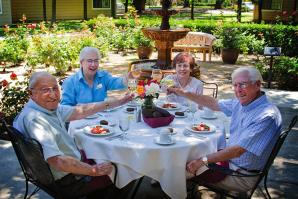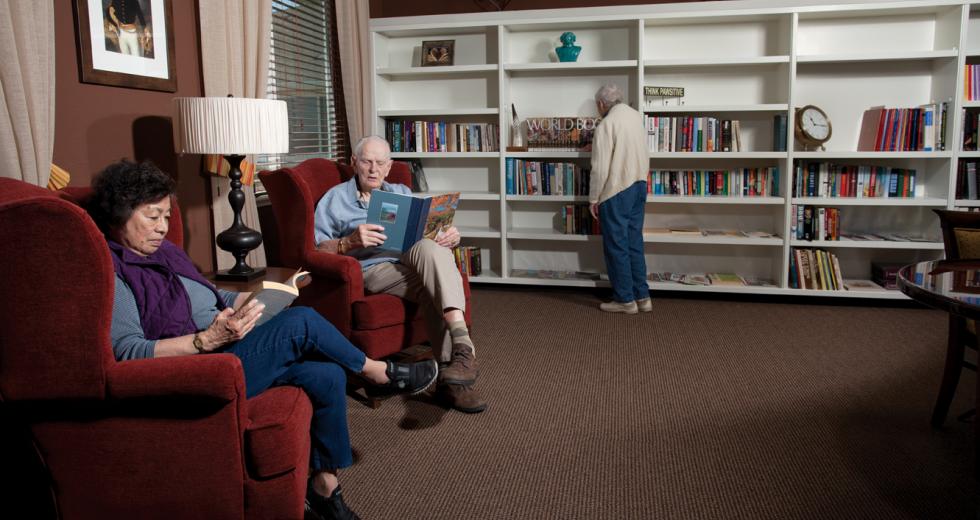As her father’s dementia deepened, so did Tonya Roemer’s anxiety. Daily visits, a stint with a live-in companion and an experiment with expensive, 24-hour care didn’t curb Ray’s aggressive behavior as the 81-year-old lost the ability to walk and feed himself.
When Ray landed in the hospital, Roemer, the youngest of five geographically scattered siblings, knew he couldn’t come home again. The family had 21 days to find a place for him to live.
And so began a frantic, in-depth search. Roemer visited 15 memory-care facilities in the Sacramento area but was distraught at the sight of scores of dementia patients with little privacy, clustered in front of television sets and dining halls. “Every one of them made me cry,” she recalls. “I couldn’t imagine visiting my father at any of them.”
At the eleventh hour, she found a facility in the Greenhaven neighborhood, midway between her workplace and home, that clicked on multiple levels.
For almost two years now, Ray has resided at The Meadows at Country Place, a 34-bed memory-care facility owned and operated by John Cimino and Rangi Giner, who have deep roots in the industry. Six evenings a week, Roemer brings dinner, feeds and visits her dad in his private room. When she travels, a network of female friends takes over.
Roemer is fortunate in that her father can afford to reside at a top-notch facility where the cost of care ranges from $4,000 to $7,000 a month. But what she discovered during the course of her search has universal applications.
“The most important thing I learned in looking at all these places is that you have to visualize not just your parent being there, but yourself going there every day,” she says. “Wherever we put my dad, it had to be someplace I was happy to go, too.”
There’s nothing happy about dementia, of course. But a growing array of senior apartments, assisted living and memory-care facilities are springing up in Elk Grove, Rancho Cordova and other suburbs where developable land is still available. As the baby boomer generation replaces the “greatest generation,” attitudes and services are evolving to accommodate their most oft-cited desires: to remain longer in their own homes, be close to family and not go broke in the process.
With 8,000 Americans turning 65 every day, the needs are urgent.
For decades, families that couldn’t afford a retirement home would move their elderly parents in with them. Due to the ‘silver tsunami,’ this arrangement is becoming more common, but technological advances have made it less burdensome.
John L. Graham, professor emeritus at the University of California, Irvine, and co-author of “All in the Family: A Creative Guide to Multigenerational Living,” points to a surge in two or more generations consolidating resources to live under one roof as a back-to-the-future trend already catching fire. “Multiple generations living together was the norm before World War II,” he points out, “and we predict it will become the norm again.”
Developers already are responding. In the Sacramento area, home-building giant Lennar has scored a hit with its Next Gen, “home within a home” residences now available in five communities. The concept — a one-bedroom apartment with a separate entrance attached to a larger home — was born of demographics and affordability. “Sharing a mortgage is a very economical way for families to address the needs of aging parents,” explains Gordon Jones, Lennar’s Northern California division president.Another new-build trend spawned by the housing crash: downsized single-family residences targeted to active retirees transitioning from the sprawling homes where they raised their families to a simpler, low-maintenance lifestyle.
Such bungalow-style dwellings, many with just two bedrooms, were once commonplace: Land Park, Curtis Park, East Sacramento and other older neighborhoods are filled with them. Lennar is experimenting with small homes in its age-restricted Destinations subdivision at Vineyard Point, a master-planned community in far south Sacramento County. A best seller is the 996-square-foot, two-bedroom, one-car-garage, solar-powered Catalina model, priced at around $180,000. The main difference between it and its 1940s predecessors: the Lennar home has ample closet space but no yard, while the bungalows of yore had big yards and skimpy closets.
Regis Homes is another developer building smaller. Its Islands at Riverlake, an infill development in the Pocket area, features single-story, 1,500-square-foot homes interspersed among two-story models twice their size. “Our buyers are the sandwich generations: young couples who don’t have time for yard work and seniors who want out of their 3,000-square-foot homes but don’t want to leave the neighborhood,” explains sales manager Christopher Playdon.
Staying “in the neighborhood,” if not in one’s own home, is important to many seniors forced to make adjustments as they enter their 70s and 80s. Upscale Hank Fisher Properties and Carmichael-based Eskaton, two of Sacramento’s leading providers of independent, assisted-living and memory-care residences for the elderly, are developing an array of services that allow seniors at all income levels to postpone the need for expensive, full-time care.
Fisher’s diversified offerings, geared to ease transitions and take the pressure off of family members, include short-term assisted living, respite care and day-care programs for clients with dementia.
Eskaton, which provides services to more than 14,000 older adults in Northern California and has more than 800 people on the waiting list for its limited amount of HUD-subsidized housing, is taking a proactive stance with a program geared to help seniors continue living in their own homes as age chips away at their mobility.
The senior living communities’ Live Well At Home social membership platform rolls out in April after a year in the trial stage, providing a range of resources for a fee of $25 to $75 a month. Components include learning and exercise classes, cultural opportunities, assistance with health-care coordination and access to vetted providers of services ranging from transportation to house cleaning and home repairs.
“It’s all wrapped up in affordability,” says Sheri Peifer, Eskaton’s senior vice president of innovation and strategic development. “We recognize that 90 percent of seniors want to live at home forever. But what we have today is an incredibly fragmented system that makes it difficult to do that. People don’t know where to turn, and they get a lot of conflicting information. Our goal is seamless coordination … We’re looking to partner with trusted vendors to create a robust service program that people can access and avail themselves of in their own homes.”
For older folks who can no longer handle the demands of living on their own, Sacramento has a growing inventory of residential facilities that accommodate a wide range of needs under one roof. With government funding and subsidy programs all but dried up, few, if any, of the new facilities fall into the “affordable” category. Competition for residents who can afford $3,000 a month and up for room and board at one of the newer places nevertheless is fierce.
“Predominantly, people are selling their homes to finance moving here, although some have long-term health insurance,” says Tracy McLinn, retirement counselor at Carlton Plaza of Elk Grove, a new, 101-unit facility where a couple living in a one-bedroom apartment pays about $4,000 a month for room, board, housekeeping, laundry service and a long list of amenities. Supportive-care services can be added on as needed, and a 36-bed Alzheimer’s unit also is on site.
The flexibility offered by Carlton Plaza is what attracted Maria Robinson, a retired staff-development specialist, and husband Frank, a retired filmmaker, to move here from Walnut Grove. The couple, both 87, lived adventurous, peripatetic lives before Frank’s memory started to fail. He needs help with the tasks of daily living. She doesn’t.
“I wanted a place that offered both independent and assisted living, so I got online and explored many places in the area,” says Maria, who still drives. Because I’d done my grocery shopping in Elk Grove and our doctors were here, this place got me excited. And it’s lovely. I’ve always been a workaholic. Now I come down every morning with my newspaper and take my time.”
Recommended For You

Better With Age
Emerging trends offer senior living with style
Retirement communities are facing the challenges that come with catering to seniors in the 21st century. These consumers — and there are a lot of them — are demanding greater access to technology, life-long learning programs and attention to overall wellness.



